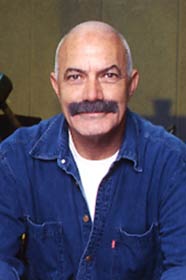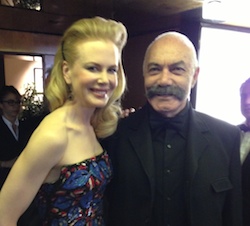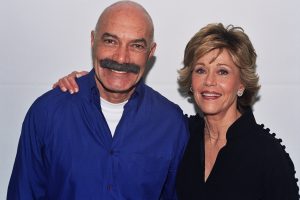If Wings, the first Oscar-winning war film, celebrates heroism, action, and male camaraderie, All Quiet on the Western Front, the third Best Picture (for 1930) delivers a more powerful, anti-war, message.
Our Grade: A- (****1/2 out of *****)
Uncompromisingly made, the film makes a clearly bleak statement of war fighting in trenches, stressing the inanity of war for both sides, the Allies and the German.
All Quiet on the Western Front contains many powerful scenes–and speeches. Expressing some German dogface philosophy at the frontlines, Louis Wolheim states: “I tell you how it should all be done. Whenever there’s a big war coming, you should rope off a big field and sell tickets. And, on the big day, you should take all the kings and cabinets and their generals, put them in the center dressed in their underpants and let them fight it out with clubs. The best country wins.

When Lew Ayres finds a Frenchman (Raymond Griffith) in a shell-hole and stabs him, only to agonize later over what he has done. He says: “When you jumped in here, you were my enemy–and I was afraid of you. But you’re just a man like me, and I killed you. Forgive me! Oh, no, you’re dead! You’re better off than I am–you’re through–they can’t do anymore to you now. Oh, God! why did they do it to us? We only wanted to live, you and I. Why should they send us out to fight each other? If we threw away these rifles and these uniforms, you could be my brother, just like Kate and Albert. You’ll have to forgive me, comrade.”
Later on, in the film’s memorable penultimate scene, Ayres sees a butterfly and spontaneously reaches out to touch it, when he is hit with a bullet. One by one, the soldiers are maimed or killed in action.

The anti-war message is loud and clear. Lew Ayres, addressing a classroom full of potential soldiers, says war: “When it comes to dying for your country, it’s better not to die at all.”
“All Quiet on the Western Front” proved to be a huge success at the box-office; it was Universal’s biggest hit. Reissued in the U.S. in 1939, in a substantially truncated version (the initial running time was 145 minutes), the movie enjoyed a second successful run and it’s often shown on TV. In later reissues, the opening commentary, on the horror and futility of war, was excised from the original.
The film was poorly received in Germany prior to Nazism, and was officially banned following Hitler’s rise to power, fearing that the film’s message would have a demoralizing effect on Germany’s youth.

Due to its pacifist message, the film has frequently been banned in countries preparing for war. It’s noteworthy that Milestone didn’t make pacifist film during WWII. Some critics have suggested that perhaps it was easier to make a movie like “All Quiet” because its protagonists-losers were Germans and not Americans.
At the time, the film was hailed as courageous, but as some historians pointed out, this was a pacifist film launched profitably during a pacifist period. To be truly “courageous,” the movie should have been made when the country was involved in the midst of a war. The American Legion of Decency was concerned about the sympathetic portrayal of Germans.
Most viewers responded to the film’s noble message the futility of war, any war, as one reviewer noted in 1930: “The League of Nations could make no better investment than to buy the master print, reproduce it in every nation to show every year until the word “war” is taken out of the dictionary.
The movie was extremely popular at the box office, both in the U.S. and in other countries all over the world.
Running Time:
| All Quiet on the Western Front | |
|---|---|

Theatrical release poster
|
|
Oscar Alert
Nominated for four Academy Awards, All Quiet on the Western Front won two: Best Production (as the Best Picture category was then called) and Director for Lewis Milestone. The other two nominations were for Writing Achievement (George Abbott, Maxwell Anderson, and Del Andrews) and for Arthur Edeson’s Cinematography.
The Writing Oscar went to Frances Marion, for “The Big House,” and the Cinematography Award to Joseph T. Rucker and Willard Van Der Meer for the documentary, “With Byrd at the South Pole.”
Narrative Structure: Detailed Plot (Spoiler Alert)
In the first scene, Professor Kantorek gives an impassioned speech about the glory of serving in the Army and “saving the Fatherland.”
On the brink of becoming men, the boys in his class, led by Paul Bäumer, are moved to join the army as the new 2nd Company.
Their romantic delusions are quickly broken during their brief but rigorous training under the abusive Corporal Himmelstoss, who bluntly informs them, “You’re going to be soldiers—and that’s all.”
The soldiers arrive by train at the combat zone, which is mayhem/ This is graphically depicted through incoming shells, horse-drawn wagons racing about, and prolonged rain.
One soldier is killed before the recruits can reach their post, to the alarm of the new soldiers (Behn). The soldiers are assigned to a unit composed of older soldiers, who are not exactly accommodating.
No food available: They have not eaten since breakfast, but the other men have not had food for two days. One named “Kat” Katczinsky goes to locate some food, but he returns with slaughtered hog he has stolen from the kitchen. The young soldiers “pay” for their dinner with soaps and cigarettes.
The recruits’ first trip to the trenches with the vets, to restring barbed wire, is a harrowing experience. Behn is blinded by shrapnel and hysterically runs into machine-gun fire.
After some days in a bunker being bombed, they move into the trenches and repulse an enemy attack; they counterattack and take an enemy trench with heavy casualties but have to abandon it. Sent back to the field kitchens to get their rations, each man receives double helpings, because of the number of dead.
Upon hearing they are to return to the front the next day, they begin discussion about the causes of the war. Tjaden speaks about himself and the Kaiser; Kat jokes that instead of having war, Europe’s leaders should be stripped to underwear and made to “fight it out with clubs.”
Corporal Himmelstoss arrives at the front and is spurned due to his bad reputation. Forced to go over the top with the 2nd Company, he is killed.
In attacking a cemetery, Paul stabs a French soldier but finds himself trapped in a hole with the dying man for an entire night. He desperately tries to help him, bringing him water but fails to stop his dying. He cries bitterly and begs the dead body to speak so he can be forgiven. Later, he returns to the German lines and is comforted by Kat.
Back at the front line, Paul is wounded and taken to a Catholic hospital, along with his good friend Albert Kropp. Kropp’s leg is amputated, which he does not find out right away.
Paul is taken to the bandaging ward, from which nobody has ever returned alive. Still, he returns to the normal rooms, only to find Kropp depressed.
During furlough and family visit, Paul is shocked by how uninformed they are about the war; they believe that final “push for Paris” is soon to occur.
When Paul visits the schoolroom where he was recruited, he finds Professor Kantorek prattling the same patriotic fervor to a class of even younger students. Kantorek asks Paul to detail his experience, at which the latter reveals that war was not at all like he had envisioned, emphasizing death.
This revelation upsets the professor, as well as the young students who label Paul a “coward.” Disillusioned and angry, Paul returns to the front and comes upon another 2nd Company filled with new recruits.
He is then happily greeted by Tjaden, and joins Kat in a discussion about people’s inability to comprehend the futility of the war. Kat’s shin is broken when a bomb is dropped, and Paul carries him back to field hospital, only to find that another explosion has killed Kat. Crushed by the loss of his mentor, Paul leaves.
In the final scene, Paul is back on the front line. He sees a butterfly just beyond his trench. Smiling, he reaches out for the butterfly, but is shot and killed by enemy sniper.
The very final sequence is rather gloomy, showing the 2nd Company arriving at the front, with the image fading out to that of a cemetery.
Remake
“All Quiet on the Western Front” was remade in 1979 as a Made for TV movie, but the first version is still the best.
Credits
Directed by Lewis Milestone
Produced by Carl Laemmle Jr.
Written by Maxwell Anderson (adaptation & dialogue); George Abbott (screenplay); Del Andrews (adaptation); C. Gardner Sullivan (supervising story chief), based on All Quiet on the Western Front by Erich Maria Remarque
Music by David Broekman
Cinematography Arthur Edeson
Edited by Edgar Adams; Milton Carruth (silent version, uncredited)
Production and distribution company: Universal Studios
Release date: April 21, 1930 (US)
Cast
Lew Ayres as Paul Bäumer
Louis Wolheim as Stanislaus Katczinsky
John Wray as Himmelstoss
Arnold Lucy as Professor Kantorek
Ben Alexander as Franz Kemmerich
Scott Kolk as Leer
Owen Davis, Jr. as Peter
William Bakewell as Albert Kropp
Russell Gleason as Müller
Richard Alexander as Westhus
Harold Goodwin as Detering
Slim Summerville as Tjaden
Walter Browne Rogers as Behn
G. Pat Collins as Lieutenant Bertinck
Edmund Breese as Herr Meyer, the Stammtisch speaker
Beryl Mercer as Frau Bäumer, Paul’s mother












